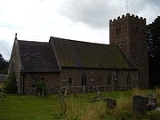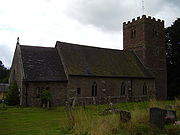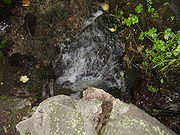
Stoke St. Milborough
Encyclopedia
Stoke St. Milborough is a parish located in Shropshire
, England
.

In 1815 there were 11 cottages on Stoke Gorse and 24 on Brown Clee. The population grew rapidly and in 1821, there were 554 inhabitants. The population remained steady until c. 1871, when it began to decline. In 1971, there were only 215 inhabitants. However, by 1991, it had risen again to 300.http://www.british-history.ac.uk/report.asp?compid=22886
 St. Milburga was a Benedictine abbess who received the veil from St. Theodore of Canterbury. Her father was the King of Mercia
St. Milburga was a Benedictine abbess who received the veil from St. Theodore of Canterbury. Her father was the King of Mercia
and she was a sister of Saints Mildred of Thanet and Mildgytha. She was the abbess of Wenlock Abbey
in Shropshire. She is supposed to have had remarkable abilities, such as levitation and power over birds. Her feast day is the 23rd of February.http://www.catholic.org/saints/saint.php?saint_id=5128
St. Milburga's (or St. Milburgha's) well is a spring with an old stone basin, on the east side of Stoke village. It was first mentioned in 1321. It later became a clothes-washing place. Stories of its miraculous origin were recorded in the mid-19th century. The water was said to be good for sore eyes. It was covered and altered in 1873 and 1906 and by 1945 its water was piped to six houses.http://www.british-history.ac.uk/report.asp?compid=22886
Shropshire
Shropshire is a county in the West Midlands region of England. For Eurostat purposes, the county is a NUTS 3 region and is one of four counties or unitary districts that comprise the "Shropshire and Staffordshire" NUTS 2 region. It borders Wales to the west...
, England
England
England is a country that is part of the United Kingdom. It shares land borders with Scotland to the north and Wales to the west; the Irish Sea is to the north west, the Celtic Sea to the south west, with the North Sea to the east and the English Channel to the south separating it from continental...
.

History
Stoke and Stanton manors were settled by 1086. There was a church at Stoke c. 1200, which seems to have incorporated vestiges of an earlier one. There was a mill at Stoke by 1334. Wool and woollen cloth seem to have been important products of the parish in the 14th century. In 1340, the parish's crops were devastated by storms, flocks dwindled and 11 tenants abandoned their holdings. In 1581, the lord of Stoke reserved to himself any mines on the waste and in 1637 he had mines of ironstone and limestone, which he was alleged to let to poor people at expensive rates. Limsetone was being quarried in Stoke manor in 1637.In 1815 there were 11 cottages on Stoke Gorse and 24 on Brown Clee. The population grew rapidly and in 1821, there were 554 inhabitants. The population remained steady until c. 1871, when it began to decline. In 1971, there were only 215 inhabitants. However, by 1991, it had risen again to 300.http://www.british-history.ac.uk/report.asp?compid=22886
St. Milburga and St. Milburga's Well

Merewalh
Merewalh Merewalh Merewalh (sometimes given as Merwal or Merewald was a sub-king of the Magonsæte, a western cadet kingdom of Mercia thought to have been located in Herefordshire and Shropshire...
and she was a sister of Saints Mildred of Thanet and Mildgytha. She was the abbess of Wenlock Abbey
Much Wenlock Priory
Much Wenlock Priory is a ruined 12th century monastery, located in Much Wenlock, Shropshire, at . The foundation was a part of the Cluniac order, which was refounded in 1079 and 1082, on the site of an earlier 7th century monastery, by Roger de Montgomery...
in Shropshire. She is supposed to have had remarkable abilities, such as levitation and power over birds. Her feast day is the 23rd of February.http://www.catholic.org/saints/saint.php?saint_id=5128
St. Milburga's (or St. Milburgha's) well is a spring with an old stone basin, on the east side of Stoke village. It was first mentioned in 1321. It later became a clothes-washing place. Stories of its miraculous origin were recorded in the mid-19th century. The water was said to be good for sore eyes. It was covered and altered in 1873 and 1906 and by 1945 its water was piped to six houses.http://www.british-history.ac.uk/report.asp?compid=22886
Famous people
- St. Milburga, Abbess of Wenlock
- Sir Thomas Littleton (1647-1710), speaker of the House of Commons 1698-1700

